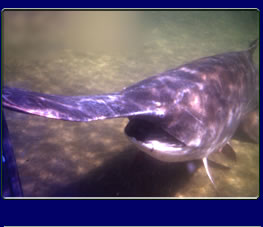- Home
- About S&T
- Taxa/Organisms
- Ecosystems
- Issues
- Methods & Tools
- Reports & Publications
- Location
- Search
May 4 2007 | Publisher: Other (Springer New York) | Format: URL
www.springerlink.com — This project is an evaluation of three potentially nonlethal alternatives to fillet sampling for the determination of mercury (Hg) concentrations in smallmouth bass (Micropterus dolomieu) to monitor mercury concentrations in smallmouth bass (micropterus dolomieu) from six sites in southern Missouri were captured by electrofishing. Blood samples More...

2002 | Publisher: USGS | Science Center: Western Fisheries Research Center (WFRC, Seattle) | Format: URL
wfrc.usgs.gov — The value of this long-term monitoring program will provide data crucial for understanding demographic and reproductive characteristics of these endangered sucker populations. This research will have wide applicability to federal, state, and tribal agencies in the basin for management and recovery efforts.
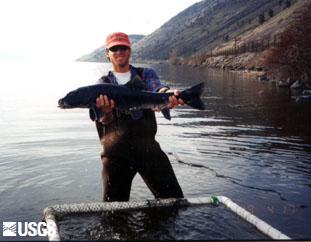
2002 | Publisher: USGS | Science Center: Great Lakes Science Center (GLSC, Ann Arbor) | Format: .PDF
www.glsc.usgs.gov — In 2002, scientists from the Great Lakes Science Center assessed the health of the populations of preyfish for the biennial State of the Lakes Ecosystem Conference (SOLEC) to provide information to policy makers on the status of the lakes and future needs. Preyfish population is one of the 80 indicators used by SOLEC to determine the health of the More...

June 2001 | Publisher: USGS | Science Center: Upper Midwest Environmental Sciences Center (UMESC, LaCrosse) | Format: URL
www.umesc.usgs.gov — This report describes an electronic database containing 474 annotated citations that are relevant to fish passage through dams in large temperate floodplain rivers. The goal of this project was to survey the literature to help define the potential ecological consequences of restricted fish passage through dams in the Upper Mississippi River System More...

September 10 2000 | Publisher: Other (Grand Canyon Monitoring and Research Center) | Format: .PDF
www.gcmrc.gov — Lees Ferry was stocked with Rainbow Trout in the early 1960`s. Since then, it has been a nationally acclaimed and world renowned blue ribbon fishery. With its value as a recreational play land for fishermen and safe haven for wildlife, the function and impact of the Glen Canyon Dam has become increasingly important for study and monitoring.

Publisher: USGS | Science Center: Western Fisheries Research Center (WFRC, Seattle) | Format: URL
wfrc.usgs.gov — This project addresses the occurrence of metal and organochlorine contaminant residues in commercial feeds purchased by the U.S. Fish and Wildlife Service (FWS) hatcheries. Research into fish feed quality could benefit all hatchery and aquaculture operations and assist in the interpretation of the effects of pollution on wild fish. Results from More...
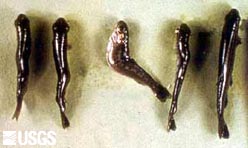
Publisher: USGS | Science Center: Western Fisheries Research Center (WFRC, Seattle) | Format: URL
wfrc.usgs.gov — Anadromous salmonids are susceptible to a variety of pathogenic microorganisms, including at least 30 bacteria and viruses. Whereas the impact of these microorganisms on salmonids in wild and natural rearing areas is difficult to measure, losses from disease among hatchery salmonids are both common and well documented. The immunology laboratory More...
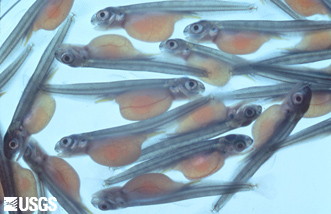
Publisher: USGS | Science Center: Western Fisheries Research Center (WFRC, Seattle) | Format: URL
wfrc.usgs.gov — Salmonid species in the Pacific Northwest continue to decline despite management efforts to mitigate the effects of development of the Columbia River basin and power system. Altered fish species diversity and changes in the aquatic habitat have created the need for research to determine the status, life history, and habitat requirements of at risk More...
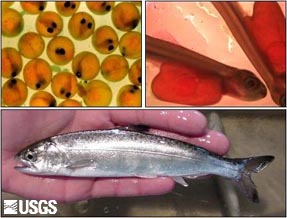
Publisher: USGS | Science Center: Western Fisheries Research Center (WFRC, Seattle) | Format: URL
wfrc.usgs.gov — Viral infections are common causes of disease outbreaks and mortalities in both wild and captive fish populations. Due to the long history of virus outbreaks there is a substantial body of knowledge about viruses within the field of fish pathology. This project involves research and development studies which create, modify and apply modern More...
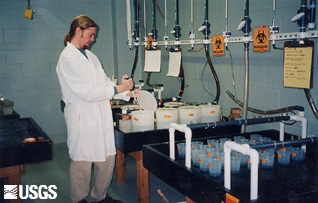
Publisher: USGS | Science Center: Western Fisheries Research Center (WFRC, Seattle) | Format: URL
wfrc.usgs.gov — Little is known about the importance of estuarine habitats for juvenile chinook salmon (Oncorhynchus tshawytscha), hence managers are uncertain of the appropriate levels of protection for such habitats. Research to determine the length of residence and growth of juvenile chinook salmon in the Skagit River estuary will indicate the importance of More...
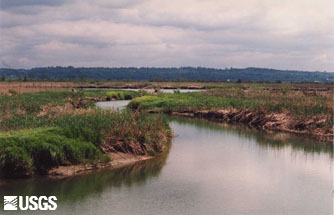
Publisher: USGS | Science Center: Western Fisheries Research Center (WFRC, Seattle) | Format: URL
wfrc.usgs.gov — Fall chinook salmon (Oncorhynchus tshawytscha) in the Snake River are currently listed as threatened under the Endangered Species Act (ESA). Although fish bypass systems reduce the mortality of fish entering turbine intakes at mainstem hydroelectric dams, they are only operated during the spring, summer, and early fall during the peaks of seaward More...

Publisher: USGS | Science Center: Upper Midwest Environmental Sciences Center (UMESC, LaCrosse) | Format: URL
www.umesc.usgs.gov — Paddlefish (Polyodon spathula) have been lost from four states and Canada, and 11 of 22 states within the remaining species range now list the paddlefish as endangered, threatened, or a species of special concern. Restoration of paddlefish populations is a shared goal of many state and federal agencies. UMESC scientists, in collaboration with the More...
